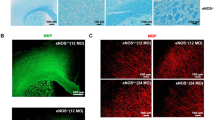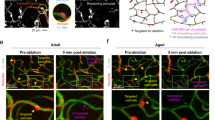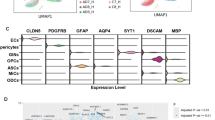Abstract
Diffuse white-matter disease associated with small-vessel disease and dementia is prevalent in the elderly. The biological mechanisms, however, remain elusive. Using pericyte-deficient mice, magnetic resonance imaging, viral-based tract-tracing, and behavior and tissue analysis, we found that pericyte degeneration disrupted white-matter microcirculation, resulting in an accumulation of toxic blood-derived fibrin(ogen) deposits and blood-flow reductions, which triggered a loss of myelin, axons and oligodendrocytes. This disrupted brain circuits, leading to white-matter functional deficits before neuronal loss occurs. Fibrinogen and fibrin fibrils initiated autophagy-dependent cell death in oligodendrocyte and pericyte cultures, whereas pharmacological and genetic manipulations of systemic fibrinogen levels in pericyte-deficient, but not control mice, influenced the degree of white-matter fibrin(ogen) deposition, pericyte degeneration, vascular pathology and white-matter changes. Thus, our data indicate that pericytes control white-matter structure and function, which has implications for the pathogenesis and treatment of human white-matter disease associated with small-vessel disease.
This is a preview of subscription content, access via your institution
Access options
Access Nature and 54 other Nature Portfolio journals
Get Nature+, our best-value online-access subscription
$29.99 / 30 days
cancel any time
Subscribe to this journal
Receive 12 print issues and online access
$209.00 per year
only $17.42 per issue
Buy this article
- Purchase on SpringerLink
- Instant access to full article PDF
Prices may be subject to local taxes which are calculated during checkout






Similar content being viewed by others
Change history
05 April 2024
This article has been retracted. Please see the Retraction Notice for more detail: https://doi.org/10.1038/s41591-024-02935-6
References
Wardlaw, J.M. et al. Neuroimaging standards for research into small vessel disease and its contribution to ageing and neurodegeneration. Lancet Neurol. 12, 822–838 (2013).
Iadecola, C. The pathobiology of vascular dementia. Neuron 80, 844–866 (2013).
Snyder, H.M. et al. Vascular contributions to cognitive impairment and dementia including Alzheimer's disease. Alzheimers Dement. 11, 710–717 (2015).
Hachinski, V. & World Stroke Organization. Stroke and potentially preventable dementias proclamation: updated World Stroke Day Proclamation. Stroke J. Cereb. Circ. 46, 3039–3040 (2015).
Phillips, O.R. et al. The superficial white matter in Alzheimer's disease. Hum. Brain Mapp. 37, 1321–1334 (2016).
Lee, S. et al. White matter hyperintensities are a core feature of Alzheimer's disease: evidence from the dominantly inherited Alzheimer network. Ann. Neurol. 79, 929–939 (2016).
Behrendt, G. et al. Dynamic changes in myelin aberrations and oligodendrocyte generation in chronic amyloidosis in mice and men. Glia 61, 273–286 (2013).
Schuff, N. et al. Cerebral blood flow in ischemic vascular dementia and Alzheimer's disease, measured by arterial spin-labeling magnetic resonance imaging. Alzheimers Dement. 5, 454–462 (2009).
Hanaoka, T. et al. Relationship between white matter lesions and regional cerebral blood flow changes during longitudinal follow up in Alzheimer's disease. Geriatr. Gerontol. Int. 16, 836–842 (2016).
Miners, J.S., Schulz, I. & Love, S. Differing associations between Aβ accumulation, hypoperfusion, blood-brain barrier dysfunction and loss of PDGFRB pericyte marker in the precuneus and parietal white matter in Alzheimer's disease. J. Cereb. Blood Flow Metab. 38, 103–115 (2017).
Arvanitakis, Z., Capuano, A.W., Leurgans, S.E., Bennett, D.A. & Schneider, J.A. Relation of cerebral vessel disease to Alzheimer's disease dementia and cognitive function in elderly people: a cross-sectional study. Lancet Neurol. 15, 934–943 (2016).
Zhao, Z., Nelson, A.R., Betsholtz, C. & Zlokovic, B.V. Establishment and dysfunction of the blood-brain barrier. Cell 163, 1064–1078 (2015).
Attwell, D., Mishra, A., Hall, C.N., O'Farrell, F.M. & Dalkara, T. What is a pericyte? J. Cereb. Blood Flow Metab. 36, 451–455 (2016).
Sweeney, M.D., Ayyadurai, S. & Zlokovic, B.V. Pericytes of the neurovascular unit: key functions and signaling pathways. Nat. Neurosci. 19, 771–783 (2016).
Daneman, R., Zhou, L., Kebede, A.A. & Barres, B.A. Pericytes are required for blood-brain barrier integrity during embryogenesis. Nature 468, 562–566 (2010).
Armulik, A. et al. Pericytes regulate the blood-brain barrier. Nature 468, 557–561 (2010).
Bell, R.D. et al. Pericytes control key neurovascular functions and neuronal phenotype in the adult brain and during brain aging. Neuron 68, 409–427 (2010).
Peppiatt, C.M., Howarth, C., Mobbs, P. & Attwell, D. Bidirectional control of CNS capillary diameter by pericytes. Nature 443, 700–704 (2006).
Hall, C.N. et al. Capillary pericytes regulate cerebral blood flow in health and disease. Nature 508, 55–60 (2014).
Yemisci, M. et al. Pericyte contraction induced by oxidative-nitrative stress impairs capillary reflow despite successful opening of an occluded cerebral artery. Nat. Med. 15, 1031–1037 (2009).
Mishra, A. et al. Astrocytes mediate neurovascular signaling to capillary pericytes but not to arterioles. Nat. Neurosci. 19, 1619–1627 (2016).
Kisler, K. et al. Pericyte degeneration leads to neurovascular uncoupling and limits oxygen supply to brain. Nat. Neurosci. 20, 406–416 (2017).
Farkas, E. & Luiten, P.G. Cerebral microvascular pathology in aging and Alzheimer's disease. Prog. Neurobiol. 64, 575–611 (2001).
Baloyannis, S.J. & Baloyannis, I.S. The vascular factor in Alzheimer's disease: a study in Golgi technique and electron microscopy. J. Neurol. Sci. 322, 117–121 (2012).
Sengillo, J.D. et al. Deficiency in mural vascular cells coincides with blood-brain barrier disruption in Alzheimer's disease. Brain Pathol. 23, 303–310 (2013).
Halliday, M.R. et al. Accelerated pericyte degeneration and blood-brain barrier breakdown in apolipoprotein E4 carriers with Alzheimer's disease. J. Cereb. Blood Flow Metab. 36, 216–227. (2016).
Montagne, A. et al. Blood-brain barrier breakdown in the aging human hippocampus. Neuron 85, 296–302 (2015).
Ghosh, M. et al. Pericytes are involved in the pathogenesis of cerebral autosomal dominant arteriopathy with subcortical infarcts and leukoencephalopathy. Ann. Neurol. 78, 887–900 (2015).
Tallquist, M.D., French, W.J. & Soriano, P. Additive effects of PDGF receptor β signaling pathways in vascular smooth muscle cell development. PLoS Biol. 1, E52 (2003).
Nikolakopoulou, A.M., Zhao, Z., Montagne, A. & Zlokovic, B.V. Regional early and progressive loss of brain pericytes but not vascular smooth muscle cells in adult mice with disrupted platelet-derived growth factor receptor-β signaling. PLoS One 12, e0176225 (2017).
Baumann, N. & Pham-Dinh, D. Biology of oligodendrocyte and myelin in the mammalian central nervous system. Physiol. Rev. 81, 871–927 (2001).
Winkler, E.A., Bell, R.D. & Zlokovic, B.V. Pericyte-specific expression of PDGΦβ receptor in mouse models with normal and deficient PDGFβ receptor signaling. Mol. Neurodegener. 5, 32 (2010).
Bell, R.D. et al. Apolipoprotein E controls cerebrovascular integrity via cyclophilin A. Nature 485, 512–516 (2012).
Daianu, M. et al. 7T multi-shell hybrid diffusion imaging (HYDI) for mapping brain connectivity in mice. Proc. SPIE–Int. Soc. Opt. Eng. 9413, 941309 (2015).
Zingg, B. et al. Neural networks of the mouse neocortex. Cell 156, 1096–1111 (2014).
Potter, G.M. et al. Enlarged perivascular spaces and cerebral small vessel disease. Int. J. Stroke 10, 376–381 (2015).
Trapp, B.D. & Nave, K.-A. Multiple sclerosis: an immune or neurodegenerative disorder? Annu. Rev. Neurosci. 31, 247–269 (2008).
Pohl, H.B.F. et al. Genetically induced adult oligodendrocyte cell death is associated with poor myelin clearance, reduced remyelination, and axonal damage. J. Neurosci. 31, 1069–1080 (2011).
Dewar, D., Underhill, S.M. & Goldberg, M.P. Oligodendrocytes and ischemic brain injury. J. Cereb. Blood Flow Metab. 23, 263–274 (2003).
Rosenzweig, S. & Carmichael, S.T. Age-dependent exacerbation of white matter stroke outcomes: a role for oxidative damage and inflammatory mediators. Stroke 44, 2579–2586 (2013).
Paul, J., Strickland, S. & Melchor, J.P. Fibrin deposition accelerates neurovascular damage and neuroinflammation in mouse models of Alzheimer's disease. J. Exp. Med. 204, 1999–2008 (2007).
Cortes-Canteli, M. et al. Fibrinogen and β-amyloid association alters thrombosis and fibrinolysis: a possible contributing factor to Alzheimer's disease. Neuron 66, 695–709 (2010).
Cortes-Canteli, M., Mattei, L., Richards, A.T., Norris, E.H. & Strickland, S. Fibrin deposited in the Alzheimer's disease brain promotes neuronal degeneration. Neurobiol. Aging 36, 608–617 (2015).
Schachtrup, C. et al. Fibrinogen inhibits neurite outgrowth via β3-integrin-mediated phosphorylation of the EGF receptor. Proc. Natl. Acad. Sci. USA 104, 11814–11819 (2007).
Ryu, J.K. et al. Blood coagulation protein fibrinogen promotes autoimmunity and demyelination via chemokine release and antigen presentation. Nat. Commun. 6, 8164 (2015).
Akassoglou, K., Yu, W.M., Akpinar, P. & Strickland, S. Fibrin inhibits peripheral nerve remyelination by regulating Schwann cell differentiation. Neuron 33, 861–875 (2002).
Akassoglou, K. et al. Fibrin depletion decreases inflammation and delays the onset of demyelination in a tumor necrosis factor transgenic mouse model for multiple sclerosis. Proc. Natl. Acad. Sci. USA 101, 6698–6703 (2004).
Adams, R.A. et al. The fibrin-derived γ377-395 peptide inhibits microglia activation and suppresses relapsing paralysis in central nervous system autoimmune disease. J. Exp. Med. 204, 571–582 (2007).
Altman, B.J. & Rathmell, J.C. Metabolic stress in autophagy and cell death pathways. Cold Spring Harb. Perspect. Biol. 4, a008763 (2012).
Mizushima, N., Yoshimori, T. & Levine, B. Methods in mammalian autophagy research. Cell 140, 313–326 (2010).
McIlwain, D.R., Berger, T. & Mak, T.W. Caspase functions in cell death and disease. Cold Spring Harb. Perspect. Biol. 5, a008656 (2013).
Choi, Y.J. et al. Inhibitory effect of mTOR activator MHY1485 on autophagy: suppression of lysosomal fusion. PLoS One 7, e43418 (2012).
Wang, T. et al. Synthesis of improved lysomotropic autophagy inhibitors. J. Med. Chem. 58, 3025–3035 (2015).
Schachtrup, C. et al. Fibrinogen triggers astrocyte scar formation by promoting the availability of active TGF-β after vascular damage. J. Neurosci. 30, 5843–5854 (2010).
Sagare, A.P. et al. Pericyte loss influences Alzheimer-like neurodegeneration in mice. Nat. Commun. 4, 2932 (2013).
Suh, T.T. et al. Resolution of spontaneous bleeding events but failure of pregnancy in fibrinogen-deficient mice. Genes Dev. 9, 2020–2033 (1995).
Shaw, M.A. et al. Plasminogen deficiency delays the onset and protects from demyelination and paralysis in autoimmune neuroinflammatory disease. J. Neurosci. 37, 3776–3788 (2017).
Wittrup, A. & Lieberman, J. Knocking down disease: a progress report on siRNA therapeutics. Nat. Rev. Genet. 16, 543–552 (2015).
De La Fuente, A.G. et al. Pericytes stimulate oligodendrocyte progenitor cell differentiation during CNS remyelination. Cell Rep. 20, 1755–1764 (2017).
Takenouchi, T. et al. Novel overgrowth syndrome phenotype due to recurrent de novo PDGFRB mutation. J. Pediatr. 166, 483–486 (2015).
Zhao, Z. et al. Central role for PICALM in amyloid-β blood-brain barrier transcytosis and clearance. Nat. Neurosci. 18, 978–987 (2015).
Basham, M.E. & Seeds, N.W. Plasminogen expression in the neonatal and adult mouse brain. J. Neurochem. 77, 318–325 (2001).
Ma, Q. et al. NLRP3 inflammasome contributes to inflammation after intracerebral hemorrhage. Ann. Neurol. 75, 209–219 (2014).
Barnes, S.R. et al. Optimal acquisition and modeling parameters for accurate assessment of low Ktrans blood-brain barrier permeability using dynamic contrast-enhanced MRI. Magn. Reson. Med. 10.1002/mrm.25793 (2015).
Barnes, S.R. et al. ROCKETSHIP: a flexible and modular software tool for the planning, processing and analysis of dynamic MRI studies. BMC Med. Imaging 15, 19 (2015).
Muir, E.R. et al. Quantitative cerebral blood flow measurements using MRI. Methods Mol. Biol. 1135, 205–211 (2014).
Ostergaard, L., Weisskoff, R.M., Chesler, D.A., Gyldensted, C. & Rosen, B.R. High resolution measurement of cerebral blood flow using intravascular tracer bolus passages. Part I: Mathematical approach and statistical analysis. Magn. Reson. Med. 36, 715–725 (1996).
Schalomon, P.M. & Wahlsten, D. Wheel running behavior is impaired by both surgical section and genetic absence of the mouse corpus callosum. Brain Res. Bull. 57, 27–33 (2002).
Winkler, E.A. et al. GLUT1 reductions exacerbate Alzheimer's disease vasculo-neuronal dysfunction and degeneration. Nat. Neurosci. 18, 521–530 (2015).
Shibata, M. et al. Selective impairment of working memory in a mouse model of chronic cerebral hypoperfusion. Stroke J. Cereb. Circ. 38, 2826–2832 (2007).
Fyffe-Maricich, S.L., Schott, A., Karl, M., Krasno, J. & Miller, R.H. Signaling through ERK1/2 controls myelin thickness during myelin repair in the adult central nervous system. J. Neurosci. Off. J. Soc. Neurosci. 33, 18402–18408 (2013).
Fazekas, F. et al. Pathologic correlates of incidental MRI white matter signal hyperintensities. Neurology 43, 1683–1689 (1993).
Cizkova, D. et al. Enrichment of rat oligodendrocyte progenitor cells by magnetic cell sorting. J. Neurosci. Methods 184, 88–94 (2009).
Zuchero, J.B. et al. CNS myelin wrapping is driven by actin disassembly. Dev. Cell 34, 152–167 (2015).
Zhu, H. et al. Effect of hypoxia/reoxygenation on cell viability and expression and secretion of neurotrophic factors (NTFs) in primary cultured schwann cells. Anat. Rec. (Hoboken) 2007, 865–870 (2010).
Gorkun, O.V., Veklich, Y.I., Weisel, J.W. & Lord, S.T. The conversion of fibrinogen to fibrin: recombinant fibrinogen typifies plasma fibrinogen. Blood 89, 4407–4414 (1997).
Liu, S. et al. Ancrod and fibrin formation: perspectives on mechanisms of action. Stroke 42, 3277–3280 (2011).
Lu, Z., Korotcova, L., Murata, A., Ishibashi, N. & Jonas, R.A. Aprotinin, but not ɛ-aminocaproic acid and tranexamic acid, exerts neuroprotection against excitotoxic injury in an in vitro neuronal cell culture model. J. Thorac. Cardiovasc. Surg. 147, 1939–1945 (2014).
Liang, Q. et al. Zika Virus NS4A and NS4B Proteins Deregulate Akt-mTOR Signaling in Human Fetal Neural Stem Cells to Inhibit Neurogenesis and Induce Autophagy. Cell Stem Cell 19, 663–671 (2016).
Guo, H. et al. Neuroprotective activities of activated protein C mutant with reduced anticoagulant activity. Eur. J. Neurosci. 29, 1119–1130 (2009).
Acknowledgements
This research was supported by US National Institute of Health grants NS100459, AG039452, NS034467 and AG023084 to B.V.Z., the Foundation Leducq Transatlantic Network of Excellence for the Study of Perivascular Spaces in Small Vessel Disease reference no. 16 CVD 05, and ES024936 to W.J.M. The authors thank M.T. Huuskonen for assistance with MRI scanning sessions.
Author information
Authors and Affiliations
Contributions
A.M., A.M.N. and Z.Z. designed and performed experiments, analyzed data and contributed to the writing of the paper. A.P.S., G.S., D.L., S.R.B., M.D., A.R., A.G., E.J.L., Y.W., J.V., M.H. and R.L. performed experiments and analyzed data. W.J.M., P.M.T., J.A.S., R.E.J. and E.M. provided guidance for some experiments and edited the paper. B.V.Z. designed all of the experiments and wrote the paper.
Corresponding author
Ethics declarations
Competing interests
The authors declare no competing financial interests.
Supplementary information
Supplementary Table & Figures
Supplementary Tables 1-4 & Supplementary Figures 1–19 (PDF 6343 kb)
About this article
Cite this article
Montagne, A., Nikolakopoulou, A., Zhao, Z. et al. RETRACTED ARTICLE: Pericyte degeneration causes white matter dysfunction in the mouse central nervous system. Nat Med 24, 326–337 (2018). https://doi.org/10.1038/nm.4482
Received:
Accepted:
Published:
Issue Date:
DOI: https://doi.org/10.1038/nm.4482
This article is cited by
-
Hippocampal capillary pericytes in post-stroke and vascular dementias and Alzheimer’s disease and experimental chronic cerebral hypoperfusion
Acta Neuropathologica Communications (2024)
-
A new insight into the role of pericytes in ischemic stroke
Acta Neurologica Belgica (2024)
-
Cognitive function in Parkinson’s disease: associations with perivascular space in basal ganglia
Neurological Sciences (2024)
-
The liver and muscle secreted HFE2-protein maintains central nervous system blood vessel integrity
Nature Communications (2024)
-
Changes in CSF sPDGFRβ level and their association with blood–brain barrier breakdown in Alzheimer’s disease with or without small cerebrovascular lesions
Alzheimer's Research & Therapy (2023)



